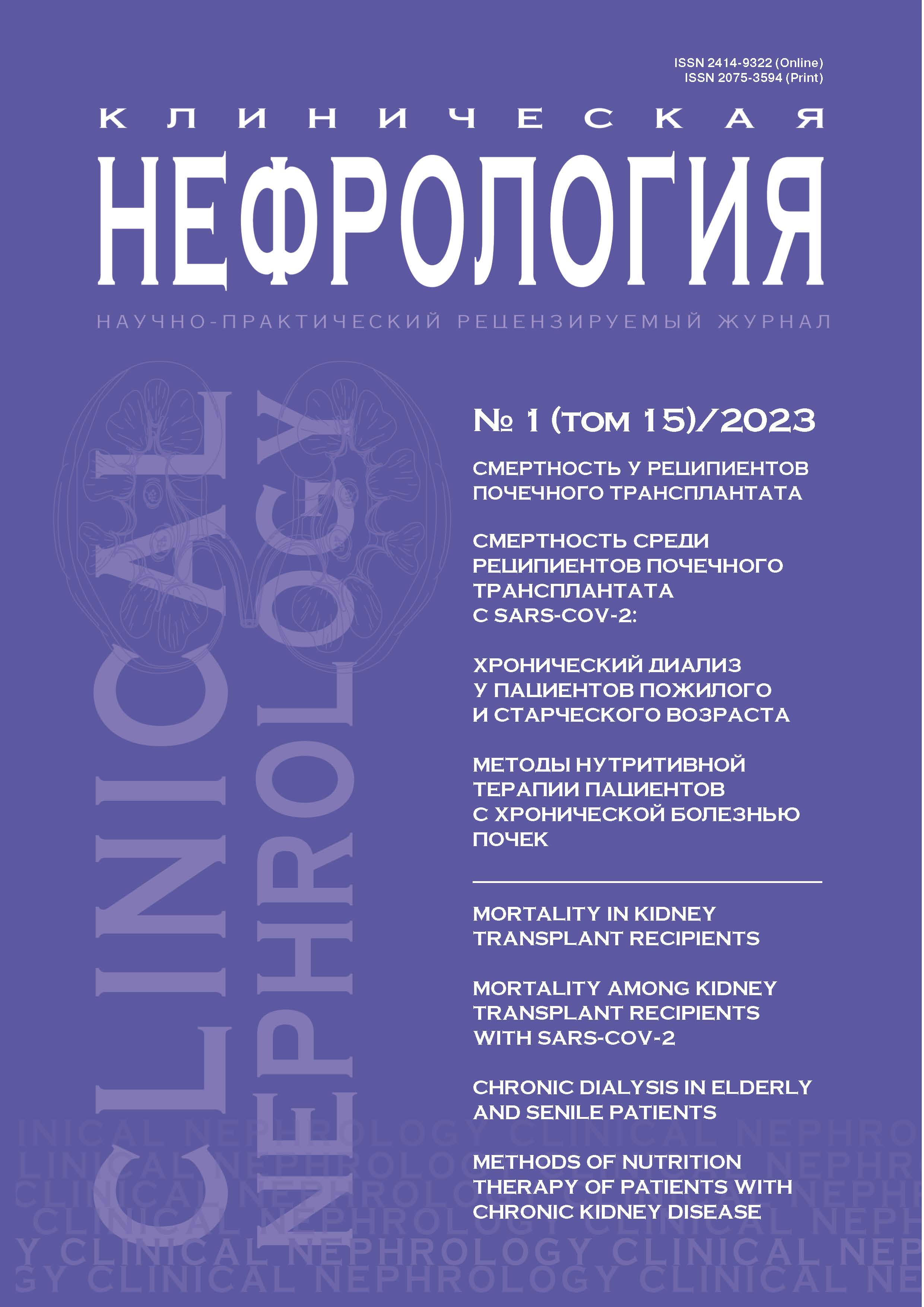Клиническая оценка селекции уропатогена in vivo
- Авторы: Бердичевский В.Б.1, Бердичевский Б.А.1, Сапоженкова Е.В.1, Павлова И.В.2, Гоняев А.Р.3, Болдырев А.Л.4, Корабельников М.А.1, Петров Д.И.1, Спирина Д.С.1
-
Учреждения:
- ФГБОУ ВО Тюменский государственный медицинский университет Минздрава РФ
- АО «Медико-санитарная часть «Нефтяник»»
- Клинический госпиталь «Мать и дитя»
- ГБУЗ ТО «Областная клиническая больница №2»
- Выпуск: Том 15, № 1 (2023)
- Страницы: 65-69
- Раздел: Нефроурология
- Статья опубликована: 20.05.2023
- URL: https://journals.eco-vector.com/2075-3594/article/view/430432
- DOI: https://doi.org/10.18565/nephrology.2023.1.65-69
- ID: 430432
Цитировать
Полный текст
Аннотация
Введение. Раскрытие механизмов экспрессии генов бактерий in vivo, индуцирующих патогенные свойства, когда они находятся в организме своего хозяина, поможет выявить новые точки приложения в разработке противомикробных препаратов.
Цель исследования: оценить влияние особенностей метаболизма глюкозы в мочевых путях (МП) на реализацию проявлений бактериурии.
Материал и методы. Проведен ретроспективный лабораторный и ПЭТ/КТ молекулярно-клеточный анализ метаболизма глюкозы в МП в совокупности с особенностями клинических проявлений бактериурии.
Результаты. Получены новые данные о биосинтетических и метаболических процессах, индуцирующих способность бактерий к различным проявлениям своего пребывания в МП человека.
Выводы. Селекция патогенных свойств у типичных представителей микробиоты МП, определяющих клиническую форму проявления бактериурии, может быть связана с особенностями метаболизма глюкозы в органах мочевой системы, что нуждается в специальном изучении и уточнении.
Ключевые слова
Полный текст
Об авторах
Вадим Борисович Бердичевский
ФГБОУ ВО Тюменский государственный медицинский университет Минздрава РФ
Email: urotgmu@mail.ru
д.м.н., профессор кафедры онкологии с курсом урологии
Россия, ТюменьБорис Аркадьевич Бердичевский
ФГБОУ ВО Тюменский государственный медицинский университет Минздрава РФ
Email: urotgmu@mail.ru
д.м.н., профессор, профессор кафедры онкологии с курсом урологии
Россия, ТюменьЕкатерина Валерьевна Сапоженкова
ФГБОУ ВО Тюменский государственный медицинский университет Минздрава РФ
Email: ekaterina_chibulaeva@mail.ru
к.м.н., доцент кафедры нормальной физиологии
Россия, ТюменьИрина Валерьевна Павлова
АО «Медико-санитарная часть «Нефтяник»»
Email: iraena@mail.ru
врач-уролог отделения урологии
Россия, ТюменьАртем Романович Гоняев
Клинический госпиталь «Мать и дитя»
Email: a.gonyaev25@yandex.ru
врач-уролог
Россия, ТюменьАлексей Леонидович Болдырев
ГБУЗ ТО «Областная клиническая больница №2»
Email: boldyrev.a.l@yandex.ru
врач-уролог
Россия, ТюменьМихаил Алексеевич Корабельников
ФГБОУ ВО Тюменский государственный медицинский университет Минздрава РФ
Email: urotgmu@mail.ru
Россия, Тюмень
Даниил Иванович Петров
ФГБОУ ВО Тюменский государственный медицинский университет Минздрава РФ
Автор, ответственный за переписку.
Email: tgmu@tyumsmu.ru
студент лечебного факультета
Россия, ТюменьДарья Сергеевна Спирина
ФГБОУ ВО Тюменский государственный медицинский университет Минздрава РФ
Email: tgmu@tyumsmu.ru
студент лечебного факультета
Россия, ТюменьСписок литературы
- Slauch J.M., Mahan M.J., Mekalanos J.J. In vivo expression technology for selection of bacterial genes specifically induced in host tissues. Meth. Enzymol. 1994;235:481–92. doi: 10.1016/0076-6879(94)35164-3.
- Antunes-Lopes T., Vale L., Coelho A.M.. The Role of Urinary Microbiota in Lower Urinary Tract Dysfunction: A Systematic Review. Eur. Urol. Focus. 2020;6(2):361–69. doi: 10.1016/j.euf.2018.09.011. [Epub 2018 Sep 28.PMID: 30270128].
- Anger J., Lee U. Recurrent Uncomplicated Urinary Tract Infections In Women: Aua/Cua/Sufu Guideline. J. Urol. 2019;202(2):282–89. doi: 10.1097/JU.0000000000000296.
- Liu F., Ling Z. Dysbiosis of urinary microbiota is positively correlated with Type 2 diabetes mellitus. Oncotarget. 2016;8(3). doi: 10.18632/oncotarget.14028.
- Gomes A.C., Bueno A.A., de Souza R.G.M., et al. Gut microbiota, probiotics and diabetes. Nutr. J. 2014;13:60. https://doi.org/10.1186/1475-2891-13-60
- Sithara C.J., Sreekumary P.K., Bacterial Profile of Urinary Tract Infection in Type 2 Diabetes Mellitus. J. Evolut. Med. Dental Sci. 2020;9(34):2407–12. doi: 10.14260/jemds/2020/524.
- Rosendah K. Pediatric Imaging The Fundamentals. Acta Radiol. 2009;50(7):125–55. https://doi.org/10.1016/B978-1-4160-5907-3.00006-4
- Lohr J.W., Chief Editor: Vecihi Batuman, Chronic Pyelonephritis Drugs & Diseases>Nephrology Drugs & Diseases > Nephrology.
- Muralikrishna B., Varma K.S.K.C., Srujanitha T. Asymptomatic bacteriuria in women with diabetes mellitus. Int. J. Sci. Res. 2017;6(6):29–31.
- Geerlings S.E., Brouwer E.C., Gaastra W. Effect of glucose and pH on uropathogenic and non-uropathogenic Escherichia coli: Studies with urine from diabetic and non-diabetic individuals. J. Med. Microbiol. 1999;48(6):535–39. doi: 10.1099/00222615-48-6-535.
- Md Jahirul Islam, Kamal Bagale, Preeti John Glycosuria Alters Uropathogenic Escherichia coli Global Gene Expression and Virulence Effect of diabetes mellitus on the uropathogenesis of uropathogenic E. coli. 2022. doi: 10.1128/msphere.00004-22. [Epub 2022 Apr 28].
- Liman M.N.P., Jialal I. Physiology, Glycosuria Last Update: March 18, 2022. [PMID: 32491373 Bookshelf ID: NBK557441].
- Kalgo Z.M., Yusuf A.B., Umar S., et al. Prevalence of Asymptomatic Bacteriuria Among Pregnant Women in Kebbi State, Nigeria. Int. J. Women’s Health Care. 2022;7(3):125–38.
- Edgar V.L., Vecihi Batuman. Asymptomatic Bacteriuria Drugs & Diseases>Nephrology. Updated: Sep 03, 2021.
- Wagenlehner F.M.E., Naber K.G., Wolfgang Weidner Asymptomatic bacteriuria in elderly patients: significance and implications for treatment. Rev. Drugs Aging. 2005;22(10):801–7. doi: 10.2165/00002512-200522100-00001.PMID.
- Okada H., Sakai Y. Detection of Significant Bacteriuria by Automated Urinalysis Using Flow Cytometry. J. Clin. Microbiol. 2000;38(8):2870–72. doi: 10.1128/JCM.38.8.2870-2872.2000.
- Gray J., Bhatti A. Hyperglycaemia, glycosuria and ketonuria may not be diabetes. Ulster. Med. J. 2003;72(1):48–9. [PMID: 12868704 PMCID: PMC2475394].
- By Danyal Dg/ Microscopic Examination of Urine CLINICAL PATHOLOGY Twitter Profile | Updated: Saturday, 06 March 2021 22:27 UTC.
- Werner R.A., Ordonez A.A., Sanchez-Bautista J., et al. New functional PET imaging of the kidney with 18F-FDS in humans. Clin. Nucl. Med. 2019;44(5):410–11. doi: 10.1097/RLU.0000000000002494.
- Ruiz-Bedoya C.A., Ordonez A.A., Werner R.A., et al. 11 C-PABA as a new PET-based radioactive tracer for functional renal imaging: preclinical and early human studies. J. Nucl. Med. 2020;61:1665–71. Doi: 10.2967/ jnumed.119.239806.
- Berdichevsky V.B., Berdichevsky B.A. The combination of positron emission and computed tomography in the study of the metabolism of chronic kidney disease. Intern. J. Radiol. Radiother. 2018;5(5):293–94. doi: 10.15406/ijrrt.2018.05.00181.
Дополнительные файлы









